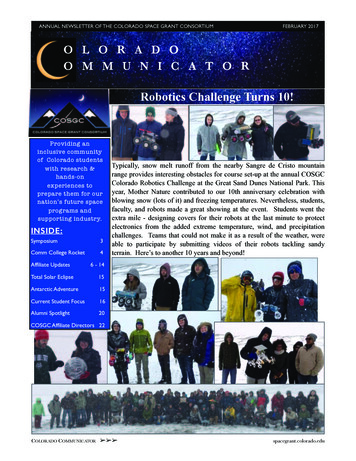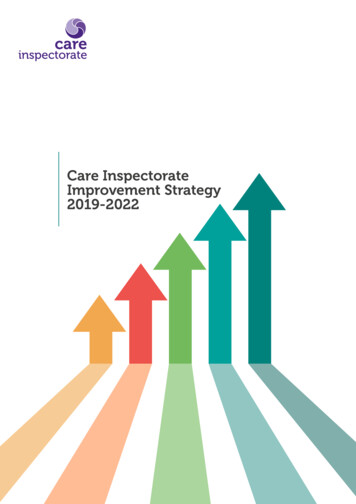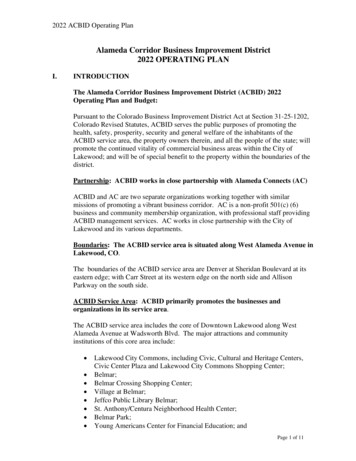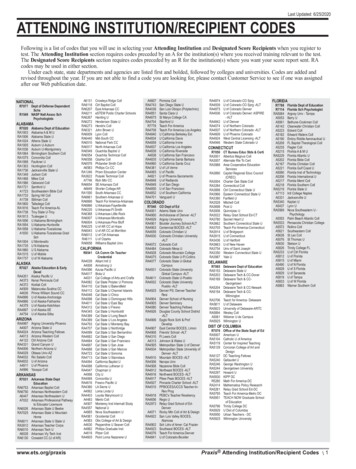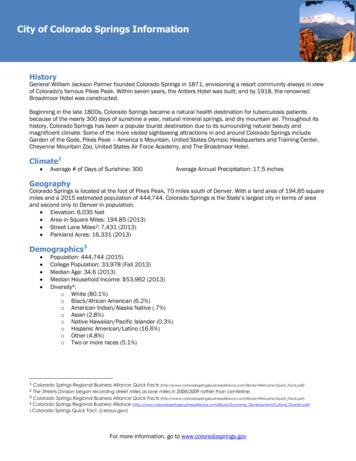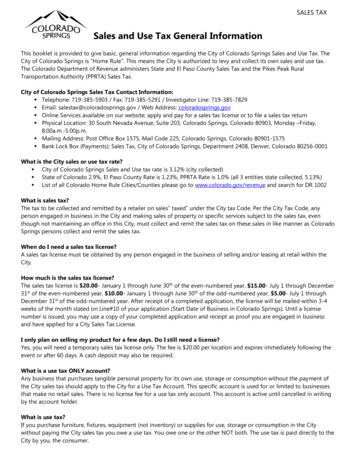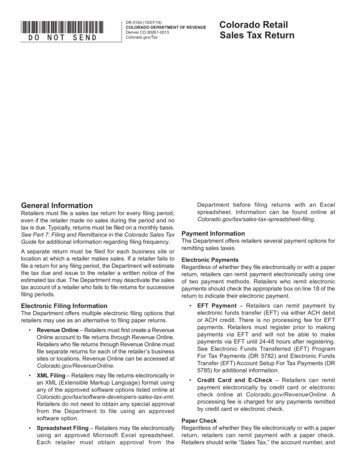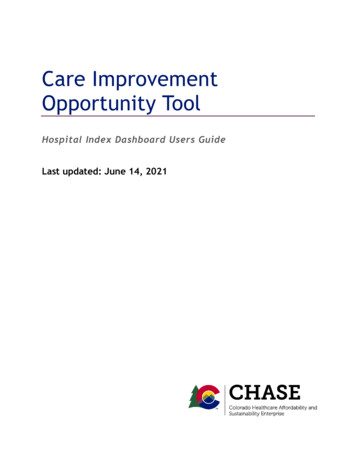
Transcription
Care ImprovementOpportunity ToolHospital Index Dashboard Users GuideLast updated: June 14, 2021
ContentsI.Background . 4II. What are Episodes? . 4III. Overview of Episode Parameters and Components . 6IV. Assembling Components for Inpatient Procedural Episode. 8V. Episode Associations . 9VI. Episode Triggers . 9A. Procedural Episode Triggers . 9B. Vaginal Delivery Episode Triggers . 9C. Pregnancy Episode Triggers. 10VII. Procedural Episode Definitions and Descriptions. 11VIII. What are AAEs? . 12IX. AAE Determination and Measurement . 13A. Relevant Service Identification . 13B. Identification of AAEs. 131. Inpatient and Outpatient Procedures . 142. Identification of Readmissions as AAE . 14C. Split vs. Unsplit AAE Costs . 143. Split Dollars . 144. Unsplit Dollars . 15X. Technical Reporting Adjustments . 16A. Annualization and Measurement Periods . 16B. Index Score Development and Statistical Significance . 161. Peer Groups . 162. Index Score. 173. Walkthrough of Index Score Calculation Steps . 17
4. Walkthrough of Index Score Credibility Analysis Steps . 23C. Risk Adjustment . 27D. Attribution to Facility and Attending Provider . 27E. Substance Use Disorder (SUD) Scrubbing . 27F. Incorporation into HTP . 28G. Population for 2021 Dashboard release . 28a. Exclusions. 28H. Eligibility Types . 28XI. Dashboard Updates and Distribution . 28A. How the Dashboards are Created . 28B. What the Dashboards Shouldn’t be Used to Measure . 29C. When the Dashboards will be Updated . 29D. Regional Accountable Entity Access to Hospital Dashboards . 29XII. Guidance on Identifying Opportunities and Interpreting Hospital IndexDashboards. 30A. Start with biggest bang for our buck. . 30B. Make fair and meaningful comparisons. . 31C. Identifying patterns. . 32D. Additional Considerations . 33XIII. Appendix . 35A. Exhibit A – Episode Associations . 35B. Exhibit B – Procedural Episode Parameters . 36C. Exhibit C – BIDM Definition of SUD for Data Scrubbing . 373 Care Improvement Opportunity Tool – Hospital Users Guide
I.BackgroundOptumas has run both fee-for-service (FFS) claims and managed care encounters,with incurred dates from SFY15 - SFY20, through the Care ImprovementOpportunity Tool (CIOT), an industry-standard episode of care grouper developedby Optumas in collaboration with Signify Health. CIOT uses detailed clinicalalgorithms to group claims and encounter data into episodes of care and comparesthe services provided, outcomes, and associated costs against clinicallydetermined best practices to identify any inefficiencies in the form of AdverseActionable Events (AAE).The results from the CIOT can be used in actuarial, clinical, contractual, andoperational settings. Optumas has been working with HCPF to analyze AAE ratesand the distribution thereof among the 43 different episodes for various programsand provider groups within Colorado Medicaid. The CIOT groups claims andencounters into episodes of care based on clinical definitions of look-back andlook-forward time periods centered around typical trigger claims and services foreach type of episode.II.What are Episodes?Episodes include all clinically related services for a discrete condition/ procedurefor the entire continuum of care - management, surgery, ancillary, labs, Rx, etc.,- for a given time frame. Each service within an episode is considered either Typical or PotentiallyActionable Episodes have been defined and refined with volunteer clinical expertsassembled in Clinical Working Groups Fully consistent with NQF recommendations on “groupers” Some episodes have been influenced more by provider participant inputbecause of ongoing implementations in other states Maternity Orthopedic procedures Behavioral Health episodes Each episode can be assigned to an attending provider (found on the episode’strigger event claim), such as the surgeon in the hospital4 Care Improvement Opportunity Tool – Hospital Users Guide
Each episode can have multiple rendering providers who provided secondary/downstream care An individual member can have multiple episodes simultaneously, but there canonly be one member involved in each episode5 Care Improvement Opportunity Tool – Hospital Users Guide
III.Overview of Episode Parameters and ComponentsRelevant Procedure (Px) Codes - CPT, HCPCS, ICD procedure codesRelevant Diagnosis (Dx) Codes - Only looks at primary Dx on hospital claims; onnon-hospital claims, can look at Dx codes in any position, depending on thesituation.1. Actionable adverse event – avoidable complications for the episodeDirectly due to the condition/treatment, such as wound infection aftersurgeryPatient safety issues such as drug-drug interactions, deep vein thrombosis2. Typical – signs and symptoms such as chest pain, shortness of breathRelevant Pharmacy (Rx) Codes - Pharmacy considered typical service unless it’srelated to a potentially avoidable hospitalization.Episode Type - Chronic, Other (maternity), or Procedural; hospitals are currentlymeasured only on Procedural episodes.Associations - Episodes are related to one another through defined clinicalassociationsTrigger Codes - Procedure and/or diagnosis codes that clearly identify thepresence of a condition, treatment, illness or injury, e.g., spine procedure code(ICD proc/CPT code). Never require multiple diagnosis codes to trigger Sufficient procedure codes do not need to be accompanied by diagnosis codeConfirmation Claim - Pharmacy or Evaluation & Management claim (E&M) claimwith a relevant diagnosis code required because providers sometimes utilizetemporary diagnosis codes on claims while they are ruling out potential diagnoses do not want to consider the process of ruling out diagnosis same as triggerevent for episode. This only applies for chronic episodes.Episode Window - Defines the start and end of an episode.Adverse Actionable Events (AAEs) - Based on Service Assignments of Typical,Typical with AAE, or AAE.6 Care Improvement Opportunity Tool – Hospital Users Guide
Negatively affect patients and (potentially) avoidable (errors, readmissions,etc.) Identified on outpatient and professional claims and encounters7 Care Improvement Opportunity Tool – Hospital Users Guide
IV.Assembling Components for Inpatient Procedural Episode
V.Episode Associations Subsumed episode costs retain their typical/AAE designation Timing and order of events are used to identify associations in addition toclinical relevance Episode to episode associations for all episodes can be found in Exhibit A Episode AssociationsVI.Episode TriggersEpisodes are identified through the presence of a trigger. Episodes triggers are acombination of procedure and diagnosis codes. The specific conditions that defineepisode triggers can vary by episode type. General trigger parameters aredescribed below, but please refer to the specific episode definition for theparameters that apply to any given episode. Links to the episode definitions canbe found in Section VII.A. Procedural Episode TriggersThree ways to trigger a procedural episode:1. Inpatient (IP) Stay - Trigger procedure code in the principal position ANDqualifying diagnosis code in the principal position2. Outpatient (OP) Facility - Trigger procedure code in any position ANDqualifying diagnosis code in any position on the same claim3. Professional - Trigger procedure code in any position AND qualifying diagnosiscode in any position on the same claimEpisode window for procedural episodes: Look-back period: 30 days prior to trigger date Look-forward period: 90 days post discharge (if IP stay) or 90 days postdate ofprocedure if non-inpatient. Deliveries are 60 days post discharge Some procedures have modified look-back or look-forward periods (e.g.,colonoscopies)B. Vaginal Delivery Episode TriggersThree ways to trigger a vaginal delivery episode:1. Inpatient Stay - Trigger procedure code in any position
2. Outpatient Facility - Trigger procedure code in any position3. Professional - Trigger procedure code in any positionEpisode window for procedural episodes: Look-back period: 3 days prior to trigger date Look-forward period: 60 days post-operative care time windowC. Pregnancy Episode Triggers Pregnancy episode is only triggered by the presence of a delivery episode. Alldelivery episodes automatically trigger a pregnancy episode Episode window for maternity episodes Look-back period: 300 days prior to delivery trigger date Look-forward period: No look-forward period Pregnancy can be looked at separately or in conjunction with the deliveryEpisodeLook-BackLook-ForwardAge RangeMaximum Eligibility GapPREGN300 days0 days12-65 30 daysVAGDEL3 days60 days12-65 0 daysC-SECT3 days60 days12-65 0 days Episodes are created but are filtered for analysis; general rule is episodes 90days in duration allow up to a 30-day gap, episodes 90 days in duration do notallow any gap Most other procedures and chronic conditions are 18-65 age limit Exhibit B in the Appendix includes parameters for procedural episodes10 Care Improvement Opportunity Tool – Hospital Users Guide
VII.Procedural Episode Definitions and DescriptionsClick the links below to access the procedural episode definitions online:Hip Replacement & HipRevisionPacemaker/DefibrillatorCABG &/or ValveProceduresHysterectomyShoulder ReplacementKnee ArthroscopyTonsillectomyCataract SurgeryKnee Replacement &Knee RevisionTransurethral ResectionProstateLumbar LaminectomyUpper GI EndoscopyBariatric SurgeryBreast BiopsyColonoscopyColorectal ResectionCoronary AngioplastyLumbar Spine FusionC-SectionLung ResectionMastectomyGall Bladder Surgery11 Care Improvement Opportunity Tool – Hospital Users GuideProstatectomyVaginal Delivery
VIII.What are AAEs? Adverse Actionable Events (AAEs) offer a powerful and detailed feedback loop toengage in process improvement through comparisons and root cause analysis An AAE is any event that negatively affects the patient and is potentially controllableby the health care delivery system – not just the individual provider or hospital The AAE measure focuses on the core outcomes that matter from the patient’sperspective, and captures a key goal of care for chronic patients: to attempt to avoidthe occurrence of exacerbations (e.g. asthma attack, hospital admission due touncontrolled schizophrenia), sequelae like diabetic foot or stroke and thedevelopment of physical co-morbidities such as liver toxicity in Substance UseDisorder (SUD) members AAEs may or may not be completely avoidable – goal is not to eliminate them but toreduce them as much as possible12 Care Improvement Opportunity Tool – Hospital Users Guide
IX.AAE Determination and MeasurementA. Relevant Service IdentificationOnce an episode is triggered, clinically relevant services are identified.All relevant services within the timeframe of an episode are included within anepisode. These include office visits, emergency room visits, inpatient professional orfacility services, labs, radiology or ancillary services. Relevant diagnosis and procedurecodes help identify which services are included. Some procedure codes are sufficient tostand alone, while others require typical or actionable adverse event (AAE) diagnosiscodes on the same claim/claim line to steer services into the episode.Relevant services can be assigned to one of three categories based on the presence orlack of complication codes:1. Typical (T) - Includes evidence-informed services related to care for the episode.e.g., anesthesia, implant, physical therapy for joint replacementsTypical care is identified through the presence of a typical care diagnosis code (seeepisode definitions) and the presence of a relevant procedure code on the sameclaim/claim line.2. Typical with AAE (T-AAE) - Services that contain an AAE diagnosis code but wouldhave occurred anyway without the presence of the complication.Dollars not included in AAE costs, but services count as AAEs for AAE countse.g., DVT, infection for joint replacements3. Adverse Actionable Event (AAE) - any event that negatively affects the patient andis potentially controllable by the health care delivery system (as identified bycomplication diagnosis codes and timing)AAE Costs capture all costs of AAEs occurring during the episode for whichpayments can be fully differentiated from those for typical services.B. Identification of AAEsAAEs are identified from the claims assigned to an episode in one of two ways: The ICD9/10 diagnosis codes in combination with relevant procedure codes13 Care Improvement Opportunity Tool – Hospital Users Guide
Type of claim (e.g., readmission or admission in chronic episodes)1. Inpatient and Outpatient Procedures AAEs during the procedure (or during the stay for inpatient procedures) Readmissions Other AAEs in the post-discharge period2. Identification of Readmissions as AAE Readmissions are AAEs and are specific to the episode, identified from diagnosiscodes relevant to the episode More specific than common “all-cause” measure in use by Medicare and othersAll costs related to the readmission are categorized as AAE (includes Rx duringreadmission)C. Split vs. Unsplit AAE CostsThe same claims are often assigned to multiple episodes. Since the dashboard containsclaim-level data for all procedural episodes, a given claim will appear more than oncein the detail underlying the dashboard.3. Split DollarsTotal dollars on a given claim are divided by the number of times a claim is used inthe model within procedural episodes. When dollars exist in both a proceduralepisode(s) and a chronic episode, the dollars are fully attributed to the proceduralepisode(s) and then split across procedural episodes. Strength: Allows user to sum dollars across all episodes and get back to theoriginal cost when looking at all episodes, at the same clinical association levelsince dollars are not duplicated; however, it is fundamentally difficult to tieback to other reports of expenditures because the tool does not process andgroup 100 percent of the claims into episodes in the first place. All data14 Care Improvement Opportunity Tool – Hospital Users Guide
underlying the dashboard already constitutes less than half of what was originallyfed into the tool Weakness: As you start to limit the number of episodes being evaluated, thesplit dollars will understate the total costs because you are likely dropping offsome of the occurrences within episodes necessary to get back to the true total4. Unsplit Dollars Strength: Accurately shows costs when looking at a single episode Weakness: As you include more episodes in your view, the level of duplicationwill increase and the sum of unsplit dollars will overstate the true total costsAs a general rule, when analyzing a single episode in isolation, using unsplit costs ispreferable; however, when looking in aggregate across multiple episodes, using thesplit costs is preferable.15 Care Improvement Opportunity Tool – Hospital Users Guide
X.Technical Reporting AdjustmentsA. Annualization and Measurement Periods The CIOT requires at least two years of incurred claims data to be runthrough the tool to produce reliable results Data runs consisting of a single year of claims/encounters do not producereliable results from which HCPF would be able to make accurate qualityincentive payments. This is because the tool does not have sufficient data toconstruct complete episodes, especially for the chronic episodes The best short-term approach is to split results into individual years based onthe service dates of the underlying incurred claims for each episode,producing three separate datapoints (one for each year). Claims that make upthe episode would be grouped according to their incurred dates. Thisapproach ensures that the reporting period experience is complete on anincurred basis, even though episodes may not retain all associated claimsexperience It is important to note that there is significant drop in episode volumewithin both the left and right tails of the time period submitted throughthe tool, due to the look-back and look-forward time periods centeredaround typical trigger claims and services as defined for the episode thetool identifies. This is why the index score is calculated on a calendaryear basis.B. Index Score Development and Statistical Significance1. Peer GroupsHospitals are categorized into four (4) peer groups based on current bed size.This is an effort to recognize that hospitals of different sizes may bepredisposed to certain episodes, i.e., larger hospitals may have morespecialized services than smaller hospitals, and to align the weights and indexscore calculation as such. The peer groups are: Bed Count: 26, Bed Count:26 – 99, Bed Count: 100 – 299, Bed Count: 299.Index Scores should only be compared between hospitals that are in the samepeer group.16 Care Improvement Opportunity Tool – Hospital Users Guide
2. Index ScoreThe Index Score is calculated for each individual hospital using the followingsteps. Each step will be described in more detail below the summary.Summary of Index Score Calculation Steps1. Calculate peer group-specific Episode Weights and Baseline Raw Scores2. Calculate hospital-specific AAE %3. Calculate Hospital Index Score4. Calculate Index Score Outliers5. Repeat Steps 1-4 in iteration until no Index Score Outliers remainSummary of Index Score Credibility Analysis StepsIndex Score Credibility Analysis requires an intermediate level of statisticalknowledge.6. Run bootstrapping statistical sampling for increasing number of IterationScenarios: 10, 50, 100, 200, 300, 400, 5007. Calculate Sample Hospital Index Scores8. Calculate key statistics from Sample Hospital Index Scores9. Use Full Credibility Formula to determine credibility of Mean Index Scorefor each Iteration Scenario10. Calculate Confidence Interval around Mean Index Score for credibleIteration Scenarios based on result from Step 911. Determine final list of hospitals that have a credible Hospital Index Scorefrom Step 5The examples provided for Index Score Calculation and Index Score Credibilityare rounded for the purposes of this document. Reproduction of the sameexamples may yield slightly different results due to rounding.3. Walkthrough of Index Score Calculation StepsIndex Scores should only be compared between hospitals that are in the samepeer group.17 Care Improvement Opportunity Tool – Hospital Users Guide
Step 1: Calculate peer-group specific Episode Weights and Baseline RawScoresThe following calculations are specific to each procedural episode and areacross all hospitals within a peer group:a. Calculate Total Episode Paid Dollarsb. Calculate Total Episode AAE Dollarsc. Calculate Episode AAE % Total Episode AAE Dollars divided by TotalEpisode Paid Dollarsd. Calculate Simple Average AAE Dollars simple average of Total EpisodeAAE Dollars across procedural episodes within a peer groupe. Calculate Simple Average AAE % simple average of Episode AAE % acrossprocedural episodes within a peer groupf. Calculate Episode AAE Dollar Relativity Total Episode AAE Dollars dividedby Simple Average AAE Dollarsg. Calculate Episode AAE % Relativity Episode AAE % divided by SimpleAverage AAE %h. Calculate Peer Group Episode Weight Episode AAE Dollar Relativitymultiplied by Episode AAE % Relativityi. Calculate Peer Group Baseline Raw Score Episode AAE % multiplied byWeightExample Calculation for Episode Weights and Baseline Raw Scores is forillustrative purposes only.Episode CategoryTonsillectomyCoronary AngioplastyVaginal DeliveryGall Bladder SurgeryUpper GI EndoscopyHysterectomyKnee ArthroscopyTotal EpisodeAAE Dollars(1a) 950,000 650,000 4,000,000 3,000,000 1,650,000 2,650,000 4,350,000Total EpisodeAAE Dollars(1b) 400,000 350,000 450,000 200,000 100,000 100,000 100,000AAE %(1c) (1b)/(1a)42.1%53.8%11.3%6.7%6.1%3.8%2.3%18 Care Improvement Opportunity Tool – Hospital Users GuideSimpleAverage AAEDollars (1d) 242,857 242,857 242,857 242,857 242,857 242,857 242,857SimpleAverageAAE % (1e)18.0%18.0%18.0%18.0%18.0%18.0%18.0%
Episode AAE DollarRelativity(1f) (1b)/(1d)Tonsillectomy1.65Coronary Angioplasty1.44Vaginal Delivery1.85Gall Bladder Surgery0.82Upper GI Endoscopy0.41Hysterectomy0.41Knee Arthroscopy0.41Episode CategoryEpisode AAE %Relativity(1g) (1c)/(1e)2.342.990.620.370.340.210.13Peer GroupEpisode Weight(1h) (1f)*(1g)3.854.311.160.310.140.090.05Peer Group BaselineRaw Score(1i) (1h)*(1c)1.622.320.130.020.010.000.00Step 2 Calculate hospital-specific AAE %The following calculations are specific to each procedural episode for eachindividual hospital:a. Calculate Hospital Episode Paid Dollarsb. Calculate Hospital Episode AAE Dollarsc. Calculate Hospital Episode AAE % Hospital Episode AAE Dollars divided byHospital Episode Paid DollarsExample Calculation for Hospital Episode AAE % is for illustrative purposes only.Episode CategoryTonsillectomyCoronary AngioplastyVaginal DeliveryGall Bladder SurgeryUpper GI EndoscopyHysterectomyKnee ArthroscopyHospital EpisodePaid Dollars (2a) 380,000 195,000 1,600,000 600,000 660,000 0 1,740,000Hospital EpisodeAAE Dollars (2b) 80,000 140,000 225,000 40,000 40,000 0 50,000Hospital Episode AAE %(2c) (2b)/(2a)21.1%71.8%14.1%6.7%6.1%N/A2.9%Step 3 Calculate Hospital Index ScoreThe following calculations are specific to each individual hospital:a. Calculate Episode Raw Score Peer Group Episode Weight multiplied byHospital Episode AAE %b. Calculate Hospital Total Baseline sum of all Peer Group Baseline RawScores for procedural episodes where hospital had historic experiencec. Calculate Episode Index Score Episode Raw Score divided by HospitalTotal Baseline multiplied by 10019 Care Improvement Opportunity Tool – Hospital Users Guide
Peer GroupEpisodeWeight (1h)3.854.311.160.310.140.090.05Episode CategoryTonsillectomyCoronary AngioplastyVaginal DeliveryGall Bladder SurgeryUpper GI EndoscopyHysterectomyKnee ArthroscopyHospitalEpisode RawEpisode AAEScore% (2c)(3a) 01N/AN/A2.9%0.00Hospital TotalBaseline(3b) Sum (1i) 14.104.104.104.104.10N/A4.10Episode Index Score(3c) (3a)/(3b)*(100)19.7675.423.970.500.20N/A0.04Step 4: Calculate and remove Index Score OutliersThe following calculations are specific to each individual hospital:a. Summarize the number of individual episodes by episode typeb. Calculate Index Score per Episode Episode Index Score / Number ofEpisodesc. Remove all episodes for an episode category that has an Index Score perEpisode over the outlier threshold. This is an effort to remove a small number of episodes that generate ahigh portion of the Hospital Index Score. Please note that not all hospitals will have episodes removed duringthis process.d. All episodes for Index Score Outliers will be removed for each hospitalExample Calculation of Index Score Outliers is for illustrative purposes only.Episode CategoryTonsillectomyCoronary AngioplastyVaginal DeliveryGall Bladder SurgeryUpper GI EndoscopyHysterectomyKnee ArthroscopyNumber of Episode IndexEpisodes (4a)Score 4Index Score perFlag Outliers New Number ofEpisode(4c)Episodes (4d)(4b) 0.00500The outlier threshold was set to 5.0 in this example. This may vary from thefinal outlier threshold used for the Index Score calculation.Hospital Total Baseline shown in (3B) is the sum of all Peer Group baseline Scores from (1i) forepisodes where the hospital had experience. In this example, the Peer Group Baseline Raw Score forHysterectomy would not be included in the Hospital Total Baseline.120 Care Improvement Opportunity Tool – Hospital Users Guide
Step 5: Repeat Steps 1-4 in iteration until no Index Score Outliers remainSteps 1-4 will be recalculated after the Index Score Outliers are removedfrom each hospital, where applicable. This will recalibrate the Peer GroupEpisode Weight and Peer Group Baseline Raw Score used to calculate theEpisode Index Score and Hospital Index Score.This process will repeat in iteration until no Index Score Outliers remain.Once that has been completed, the final Hospital Index Score is calculated asthe sum of all Episode Index Scores. This is shown as (5A) at the end of theexample calculation below.The following tables represent the same examples from above in Steps 1-3,assuming the only Index Score Outliers are for the example hospital forCoronary Angioplasty.Example re-calculation of steps 1-4 after removing Index score outliers – forillustrative purposes only.Episode CategoryTonsillectomyCoronary AngioplastyVaginal DeliveryGall Bladder SurgeryUpper GI EndoscopyHysterectomyKnee ArthroscopyEpisode CategoryTonsillectomyCoronary AngioplastyVaginal DeliveryGall Bladder SurgeryUpper GI EndoscopyHysterectomyKnee ArthroscopyTotal EpisodePaid Dollars(1a) 950,000 455,000 4,000,000 3,000,000 1,650,000 2,650,000 4,350,000TotalEpisode AAEDollars (1b) 400,000 210,000 450,000 200,000 100,000 100,000 100,000Episode AAE DollarRelativity(1f) (1b)/(1d)1.790.942.020.900.450.450.45AAE %(1c) (1b)/(1a)42.1%46.2%11.3%6.7%6.1%3.8%2.3%Episode AAE %Relativity(1g) (1c)/(1e)2.492.730.670.390.360.220.1421 Care Improvement Opportunity Tool – Hospital Users GuideSimpleAverage AAEDollars (1d) 222,857 222,857 222,857 222,857 222,857 222,857 222,857Peer GroupEpisode Weight(1h) AAE % (1e)16.9%16.9%16.9%16.9%16.9%16.9%16.9%Peer GroupBaseline Raw Score(1i) (1h)*(1c)1.881.190.150.020.010.000.00
Episode CategoryTonsillectomyCoronary AngioplastyVaginal DeliveryGall Bladder SurgeryUpper GI EndoscopyHysterectomyKnee ArthroscopyEpisode CategoryTonsillectomyCoronary AngioplastyVaginal DeliveryGall Bladder SurgeryUpper GI EndoscopyHysterectomyKnee ArthroscopyHospital Episode Paid Dollars(2a) 380,000 0 1,600,000 600,000 660,000 0 1,740,000Peer Group EpisodeWeight (1h)4.472.571.340.350.160.100.06Episode CategoryTonsillectomyCoronary AngioplastyVaginal DeliveryGall Bladder SurgeryUpper GI EndoscopyHysterectomyKnee ArthroscopyHospital EpisodeAAE % (2c)21.1%N/A14.1%6.7%6.1%N/A2.9%Number of Episodes(4a)2000300100300N/A500Hospital Episode AAE Dollars(2b) 80,000 0 225,000 40,000 40,000 0 50,000Episode Raw Score(3a) (1h)*(2c)0.94N/A0.190.020.01N/A0.00Episode Index Score(3c)45.51N/A9.141.140.47N/A0.08Hospital Episode AAE %(2c) (2b)/(2a)21.1%N/A14.1%6.7%6.1%N/A2.9%Hospital Total Baseline(3b) Sum (1i) 22.072.072.072.072.072.072.07Index Score per Episode(4b) (3c)/(4a)0.23N/A0.030.010.00N/A0.00Episode Index Score(3c) (3a)/(3b)*10045.51N/A9.141.140.47N/A0.08Flag Outliers (4c)N/AN/ACalculate Hospital Index Score sum of Episode Index Score from (3C) after all outliers have been removed across allhospitalsHospital Index Score (5a) 56.34Hospital Total Baseline shown in (3B) is the sum of all Peer Group baseline Scores from (1i) for episodes where the hospital had experience. Inthis example, the Peer Group Baseline Raw Score for Hysterectomy would not be included in the Hospital Total Baseline.222 Care Improvement Opportunity Tool – Hospital Users Guide
4. Walkthrough of Index Score Credibility Analysis StepsIndex Score Credibility Analysis requires an intermediate level of statisticalknowledge.Step 6: Run bootstrapping statistical sampling for increasing number ofIteration Scenarios: 10, 50, 100, 200, 300, 400, 500The bootstrapping statistical sampling is
10 Care Improvement Opportunity Tool - Hospital Users Guide . 2. Outpatient Facility - Trigger procedure code in any position 3. Professional - Trigger procedure code in any position Episode window for . procedural. episodes: Look-back period: 3 days prior to trigger date Look-forward period: 60 days post-operative care time window
